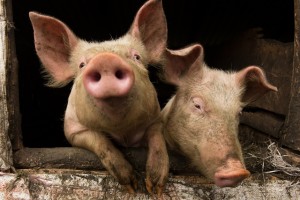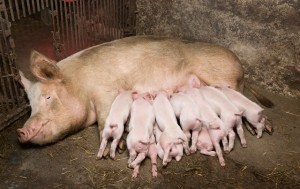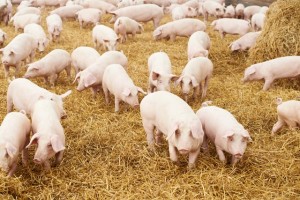Pig Diseases
An Introduction to Respiratory Disease in Pigs
Including the following conditions: Pneumonia, Pleuropneumonia, Enzootic Pneumonia
Enzootic Pneumonia in Pigs

Enzootic pneumonia mainly affects piglets and growing pigs up to about 6 months of age but can cause respiratory infection pigs of all ages.
Enzootic pneumonia is a contagious respiratory tract infection caused by the pulmonary bacterial pathogen Mycoplasma hyopneumoniae. It is spread by an airborne route, primarily during close contact between animals (Taylor, 1999). Most commonly, it affects piglets and growing pigs up to 6 months of age (Cowart, 1995).
Affected stock exhibit anorexia, loss of condition, fever and chronic coughing (Cowart, 1995). In the acute form, mortality is observed in adults and in up to 50% of piglets (Taylor, 1995). More common is the chronic form in which clinical signs are less obvious, although coughing and respiratory distress may be observed, as well as uneven growth rates within litters and groups of piglets (Taylor, 1995). The lung lesions are characterised by well-defined, greyish-red depressions in cranioventral areas (Batista Linhares et al., 2015; Pallarés et al., 2015).
Less lung damage due to enzootic pneumonia was observed in an outdoor (part-Meishan or part-Duroc crossed with Large White) genotype compared with an indoor (Large White X Landrace) genotype kept under similar outdoor and indoor conditions (Guy et al., 2002). However, wild boar have been implicated as a source of infection in the re-emergence of enzootic pneumonia in Switzerland and enzootic pneumonia outbreaks in domestic pigs were strongly correlated with outdoor piggeries (Batista Linhares et al., 2015).
Pleuropneumonia in Pigs

Actinobacillus pleuropneumoniae can be transmitted from sow to offspring during the nursing period and maternal antibodies only offer limited protection against lung infections caused by A. pleuropneumoniae (Vigre et al., 2003).
Pleuropneumonia is caused by the highly contagious respiratory tract pathogen Actinobacillus pleuropneumoniae resulting in lung infection and pneumonia. A. pleuropneumoniae mainly colonises tonsils in pigs where it can remain without causing disease (Gottschalk, 2015). Infected pigs however pigs may exhibit anorexia, fever and laboured breathing, especially after exertion (Taylor, 1995). Onset can be very rapid and finding dead pigs may be the first observation (Gottschalk, 2015).
Infection can be transmitted from dam to offspring in the early nursing period. Infected tonsils have been detected very early in life (Vigre et al., 2002), even in the presence of maternally derived antibodies (Chiers et al., 2002), however, the degree of colonisation increases as colostral antibodies decline (Vigre et al., 2002). The duration that colostral antibodies are detectable varies from 2 weeks to 2 months postpartum, depending on the initial level of acquired colostral antibodies to A. pleuropneumoniae (Vigre et al., 2003). In intensive systems, up to 30% of a herd may be infected, with mortalities reaching 50% (Taylor, 1995). Pigs surviving the disease often suffer from reduced growth rates and frequently become asymptomatic carriers and are the main cause of bacterial dissemination (Taylor, 1999).
Other respiratory diseases:
- Atrophic Rhiniti
- Porcine Reproductive and Respiratory Syndrome (PRRS)
- Streptococcal Infections
- Swine Influenza
Control and Prevention of Pneumonia in Pigs

Intensive pig units are considered to be at more risk of pneumonia outbreaks. All in all out can interrupt the cycle of many pathogens, and it provides an opportunity for a thorough clean of facilities between batches.
Improvement of the management practices is critical in the control of pneumonia in pigs. Instituting management changes that reduce the possibilities of spreading M. hyopneumoniae and A. pleuropneumoniae or result in decreased lung damage by other pathogens may lead to considerable improvement in the control of pneumonia (Maes et al., 2008).
All-in, all-out production can interrupt the cycle of pathogen transmissions from older to younger pigs, and it allows the clean the facilities between batches of pigs (Maes et al., 2008). Closed pig herds or production systems have a more stable herd immunity compared to herds where (breeding) pigs are purchased (Maes et al., 2008).
Animals exposed to stress, and in particular stress related to fluctuating temperatures, damp conditions and draughts, will be most susceptible to the disease (Done, 1991). Low stocking rates will help to avoid overcrowding and reduce the risk of infection spreading. Outdoor conditions should ensure that herds are less likely to suffer severely from pneumonia.
In order to control disease efficiently in herds endemically infected with A. pleuropneumoniae, serology should be used for routine surveillance of herds that are possibly infected (Gottschalk, 2015). There are 15 different A. pleuropneumoniae serotypes. In the UK, vaccination is only available for strains 3, 6 and 8 and there is no cross-strain protection.
Vaccines are available for enzootic pneumonia also, but since outdoor units are not known to be particularly susceptible, their use should only be considered on the advice of a nominated veterinarian and in exceptional circumstances (Taylor, 1999).
Treating Pneumonia in Pigs
The ‘gold standard’ technique used to diagnose M. hyopneumoniae infection, bacteriological culture, is laborious and is seldom used routinely. ELISA and Real-time PCR detection methods, in addition to post-mortem examination for abattoir surveillance or field inspection are most frequently used most commonly used to diagnose M. hyopneumoniae (Sibila et al., 2009).
Effective treatment of both enzootic pneumonia and pleuropneumonia involves antibiotics, although this is only effective in the early stages of the diseases and will not eradicate them from the herd (Taylor, 1999).
Pneumonia in Pigs and Welfare
In intensive indoor pig production systems, pneumonia should be considered a major welfare problem due to its widespread nature and severe lung lesions found at slaughter. Whilst there is very little published evidence on the level of pneumonia in outdoor systems, the limited data suggests that this is very low and not likely to be of welfare significance.
Good Practice Based on Current Knowledge
- Minimise contact between infected and non-infected pigs by screening animals entering the herd, isolating infected stock and lowering stocking rates
- Buy in animals from herds accredited free of Enzootic pneumonia or Actinobacillus pleuropneumoniae
- Screen any new source of supply of stock for the above diseases
- Limit factors which destabilise immunity such as reduce stress and discomfort by maintaining clean, dry, draught-free and warm housing conditions
- Avoid contact between outdoor pigs and any wild boar populations.


 American English
American English

Comments are closed.